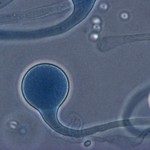Lien vers Pubmed [PMID] – 32345637
Lien DOI – e03364-1910.1128/mBio.03364-19
mBio 2020 Apr; 11(2):
Candida auris has emerged globally as a multidrug-resistant yeast that can spread via nosocomial transmission. An initial phylogenetic study of isolates from Japan, India, Pakistan, South Africa, and Venezuela revealed four populations (clades I, II, III, and IV) corresponding to these geographic regions. Since this description, C. auris has been reported in more than 30 additional countries. To trace this global emergence, we compared the genomes of 304 C. auris isolates from 19 countries on six continents. We found that four predominant clades persist across wide geographic locations. We observed phylogeographic mixing in most clades; clade IV, with isolates mainly from South America, demonstrated the strongest phylogeographic substructure. C. auris isolates from two clades with opposite mating types were detected contemporaneously in a single health care facility in Kenya. We estimated a Bayesian molecular clock phylogeny and dated the origin of each clade within the last 360 years; outbreak-causing clusters from clades I, III, and IV originated 36 to 38 years ago. We observed high rates of antifungal resistance in clade I, including four isolates resistant to all three major classes of antifungals. Mutations that contribute to resistance varied between the clades, with Y132F in ERG11 as the most widespread mutation associated with azole resistance and S639P in FKS1 for echinocandin resistance. Copy number variants in ERG11 predominantly appeared in clade III and were associated with fluconazole resistance. These results provide a global context for the phylogeography, population structure, and mechanisms associated with antifungal resistance in C. aurisIMPORTANCE In less than a decade, C. auris has emerged in health care settings worldwide; this species is capable of colonizing skin and causing outbreaks of invasive candidiasis. In contrast to other Candida species, C. auris is unique in its ability to spread via nosocomial transmission and its high rates of drug resistance. As part of the public health response, whole-genome sequencing has played a major role in characterizing transmission dynamics and detecting new C. auris introductions. Through a global collaboration, we assessed genome evolution of isolates of C. auris from 19 countries. Here, we described estimated timing of the expansion of each C. auris clade and of fluconazole resistance, characterized discrete phylogeographic population structure of each clade, and compared genome data to sensitivity measurements to describe how antifungal resistance mechanisms vary across the population. These efforts are critical for a sustained, robust public health response that effectively utilizes molecular epidemiology.




